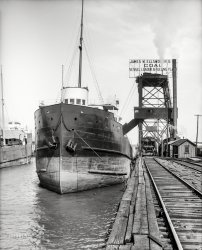
MAY CONTAIN NUTS

Search Shorpy
SHORPY ART

Framed or unframed, desk size to sofa size, printed by us in Arizona and Alabama since 2007. Explore now.
Join and Share
Ad-Free Shorpy
Shorpy is funded by you. Patreon contributors get an ad-free experience.
Learn more.

Recent comments
- Recent view
- Hudson’s Big Store
- Say what??
- Grapes?!
- A Beautiful Moment
- Such joy
- Bethune-Cookman University today...
- Yellow sky at morning
- Side Winder
- Air Quality?
- Sojourner Truth riot
- None were so blind(ed)
- The less famous sister
- Good ol' days?
- Rise and Fall
- Goo Goo Ga Joob
- Ticket Retention
- Not the only one
- Vagaries of War
- Killed by Amtrak
- Back to the Future
- Wanted --
- If you can't stand the light
- Centralized Traffic Control, I believe
- What's really happening
- Heckuva remote control!
- Sometimes — Things Go Bump!
- I SEE THE LIGHT
- Union Switch and Signal Company
- Get That Light Out Of My Eyes
Member Photos
The Shorpy
Print Emporium
Print Emporium
Search Shorpy
Search results -- 30 results per page
- Erie Canal: 1904
- "1904. Erie Canal at Salina Street, Syracuse, New York." Detroit Publishing Company glass ... always tell your pal,
If you've ever navigated
On the Erie Canal.
-- "Low Bridge" by Thomas S. Allen
Clinton Square ... Posted by Dave - 08/01/2012 - 1:34pm -
![Erie Canal: 1904 "1904. Erie Canal at Salina Street, Syracuse, New York." Detroit Publishing Company glass negative, Library of Congress. View full size.
Watch Yer HeadLow bridge, everybody down.
For it's low bridge,
We're coming to a town!
You can always tell your neighbor,
You can always tell your pal,
If you've ever navigated
On the Erie Canal.
-- "Low Bridge" by Thomas S. Allen
Clinton SquareLooks like this is now a large public fountain if, as it appears, this current shot is taken from almost the exact same angle.
http://www.panoramio.com/photo/12595565
(Click the photo for Shorpyesque "Hi-Def Image")
Stone GorgeousAll the elaborate stonework of the buildings along the canal makes the scene look something like Venice. Was that intentional, or not? I'd say that it was.
I once spent a summer in Venice,
And I had a yen to play tennis,
But those darn canals were a menace,
So I didn't play tennis in Venice.
-- Frank Crumit (1931)
Horse PowerIn 1904 I would have expected real horse or mule power to pull the barges but it appears there is no path on one side and, to the left, it stops. Is this a terminus or are they perhaps using coal?
Stairway to HeavenLove the stairs to nowhere. But wait! Not to nowhere. The stairs become very valuable when the bridge is up. While up, canal boats can pass underneath and pedestrians can use the stairs to cross without having to wait for the bridge to come back down. I've never seen a bridge like that.
Path to somewhereI live in Syracuse, the path on the left stops in Albany. They do have some steamers in this shot though. Behind the photographer, the canal split, the Erie to Buffalo, the Oswego Canal to, well, Oswego a port city on Lake Ontario. This scene lasted only 12 more years until the Barge Canal opened. Then the Erie thru Syracuse was filled in (with garbage)and became Erie Boulevard, one of Syracuse's main thoroughfares .
The grassy knoll was replaced by the Soldiers and Sailors monument and the City of Syracuse recently place park at this same spot.
Clinton SquareThe old Erie Canal as it ran through downtown Syracuse has been paved over (now Erie Boulevard). There is a small pond-like area in the view you see, also used for winter ice-skating and outside concerts when drained. In the Shorpy view to the left and right of the canal were unloading docks and an outdoor market. To the right is the beautiful old Onondaga Bank Building, in the middle the Gridley Building and to the left the old Syracuse Savings Bank. All of these buildings remain and form what is today known as Clinton Square.
Syracuse Savings Bank"Main Street, U.S.A." notes that the 1876 Syracuse Savings Bank on the left is a steel-framed "textbook example" of High Victorian Gothic designed by Joseph Lyman Silsbee. A graduate of the first American school of architecture (the Massachusetts Institute of Technology), Silsbee is noted as mentor to to a generation of architects including Frank Lloyd Wright.
Steam PowerBy 1904 they were probably using steam-powered barges on the Erie, as they were doing then on the canals here in Illinois.
[News clips mention Erie barges being moved by tugboats -- electric and steam-powered. - Dave]
Beautiful city and canal.I do like this area of New York. The money used to build the Erie Canal was well spent and then some.
Erie CanalI have lived in Syracuse since 1933. Although the Erie Canal as it went through the center of Syracuse has been filled in, the essence of the canal remains. The circa 1845 Weigh Lock Building two blocks East of the photograph is a museum, and many of the engineering marvels of the Erie Canal still remain as mini parks and hiking trails along the towpaths, like the "water over water over water" display in the park on Butternut Drive in DeWitt. The citizens in the communities all along of the Erie Canal have done a great job preserving it and encouraging tourism.
The 'Ear-I-Ee' CanalWell, someone had to say it!
(The Gallery, Boats & Bridges, DPC, Syracuse)](https://www.shorpy.com/files/images/4a12105u.thumbnail.jpg)
- Erie Canal: 1910
- Utica, New York, circa 1910. "Erie Canal at Utica." 8x10 inch dry plate glass negative, Detroit Publishing ... of where it intersects with Broad. The route of the old Erie through Utica was filled in and is now Oriskany St.
That's ... Posted by Dave - 09/29/2012 - 10:20am -
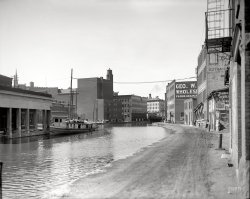
- Syracuse Panorama: 1901
- ... Syracuse, New York, circa 1901, in a panoramic view of the Erie Canal combining three 8x10 inch glass plates. Detroit Publishing Company. ... Posted by Dave - 07/28/2012 - 4:16pm -

- Barge Wife: 1941
- ... October 1941. "This barge wife is painting up the ship. Erie Canal, New York." Medium-format nitrate negative by John Collier. View full ... Posted by Dave - 11/01/2012 - 2:40pm -
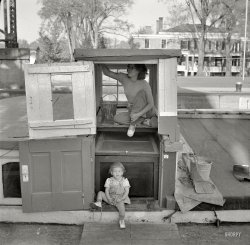
- Syracuse Bids You Welcome: 1904
- ...
Holy Schnikes! What a fortress!
On the Erie Canal City Hall was built about 50 yards off the old Erie Canal, which ran ... Posted by Dave - 07/29/2012 - 10:08am -
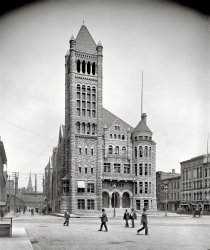
- Unloading: 1900
- ... Terminal Facilities for Ore and Coal Traffic on Lake Erie.
Buffalo, N.Y.
Delaware, Lackawanna & Western ... Look at all of those barges waiting to go back up the Erie Canal.
Steam or electric? I'd say steam from the steam plant on the ... Posted by Dave - 08/08/2012 - 7:36pm -
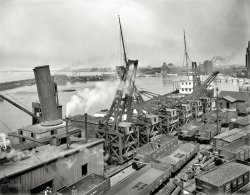
- City of Angles: 1915
- ... at the bottom of the photo is a remnant of the Miami and Erie Canal. Ten locks were required to descend the 3/4 mile distance to the Ohio ... Posted by Dave - 04/14/2023 - 10:44am -
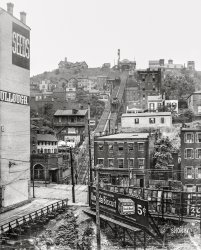
- This Smoky Eden: 1905
- Circa 1905. "Erie Canal and Mohawk Valley, Utica, N.Y." Panorama of two 8x10 inch glass ... Detroit Publishing Company. View full size.
Canal Boat Carl T. Seibel There is a town about 10 miles up canal from this ... Posted by Dave - 01/03/2018 - 10:13pm -
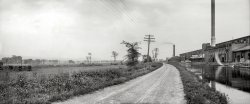
- Buffalo: 1900
- ... in the caption. - Dave]
Buffalo wings Right above Erie Railroad car 44176 looks to be a Free Chicken!
What a layout! I ... Buffalo has unearthed the very beginning of the Erie Canal which is somewhere in this photo. It is now part of our waterfront park ... Posted by Dave - 07/22/2012 - 10:38am -
![Buffalo: 1900 Circa 1900. "Buffalo, New York. Creek and elevators near foot of Main Street." Detroit Publishing Company glass negative. View full size.
Snow vs. PaperHow did those buildings that look like they're covered in paper survive the brutal winters that Buffalo is famous for?
[Those are the grain elevators mentioned in the caption. - Dave]
Buffalo wingsRight above Erie Railroad car 44176 looks to be a Free Chicken!
What a layout!I swear it's a model railroad masterpiece.
I love this oneI've had this up on my screen for a long time. I long to walk through this city at this particular time and place. Chances are little of what we see here remains.
Wow The only remaining structures that I can ID would be County Hall, the Ellicott Square building and a couple of churches. Check out the Watson Elevator standing to the left. That's a 23 foot deep turning basin now. The detail level is outstanding, thanks man!
-B in B
Buffalo elevatorsIn the next three decades, milling would continue to grow as an industry in Buffalo. In 1930 it would take the title from Minneapolis as the world's largest miller.
Life Long BuffalonianWish you could see all these wonderful buildings today. People come from all over the world to see Buffalo's Architecture. I am presently working just around the corner from the Ellicott Square Building which when completed was the largest office building in the country. The other buildings B in B mentions below are even more spectacular! Buffalo has unearthed the very beginning of the Erie Canal which is somewhere in this photo. It is now part of our waterfront park as a tourist attraction.
William James on Buffalo"We had passed great smoky Buffalo in the raw vernal dawn – with a vision, for me, of curiosity, character, charm, whatever it might be, too needfully sacrificed, opportunity perhaps forever missed…"
-- The American Scene, p. 477
This photo pretty much sums it up.
Somewhere in there. . .is my grandfather, age 11. Thanks for posting this.
More detail I also did notice the Old Post Office's (now ECC) tower to the right between the Marine Legs of the paper covered elevator.
If you look close you can see a DL&W passenger train between the buildings across the crick, pulled into the original passenger station's platforms. That is now the old parking lot for the Naval Park, under the Skyway.
The Erie Canal Commercial Slip the previous poster mentioned is located just behind the white freighter docked at the terminal along the river.
Trains in the streetsI love the trains running right through the streets. As a lifelong Buffalonian, I would love to go back and live in this time for a week -- maybe around the time of the Pan American Expo.
1894 Buffalo AtlasThe map from the 1894 Buffalo Atlas depicting the foreground and buildings directly across the Buffalo River is here.
What is interesting about this is that the two elevators on the map and should be in the foreground (Sturgis Elevator and Eastern Elevator) were demolished by 1900. The little house is the little yellow rectangle with rear extension at the end of Ganson Street and the brick building all the way at the end is the remnant of the Sturgis Elevator. I think an alternate caption for this photo should be "Demolition of the Eastern Elevator, Buffalo NY, c. 1900." You can see the guys with picks and wheelbarrows and the piles of scrap metal being towed to the rivers edge, presumably for loading on a barge. Temporary tracks have been laid to allow for the movement of the scrap, tracks that do not appear in the 1894 Buffalo Atlas.
The end of Washington Street and Wilkeson and Wells elevators are directly across the river. The Lyons Elevator is on the left.
The layout of the DL&W complex at the end of Main Street is here.
(The Gallery, Boats & Bridges, Buffalo NY, DPC, Railroads)](https://www.shorpy.com/files/images/4a06148a.thumbnail.jpg)
- Jack-Knife Bridge: 1905
- ... New York, circa 1905. "Jack-Knife Bridge, City Ship Canal, foot of Michigan Street." Detroit Publishing Company glass negative. ... rather than a large wooden wheel. Also note the Erie Canal style barge tied up at the foot of the Kellogg warehouse.
Smoke ... Posted by Dave - 07/22/2012 - 10:39am -
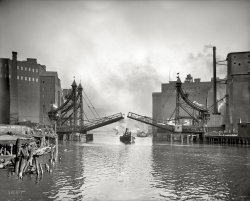
- Clinton Square: 1905
- ... to. Also great to see products moved by boat, what canal is that??
[The Erie Canal. -Dave]
Detailed Picture! The headboard and chairs appear ... Posted by Dave - 07/30/2012 - 4:36pm -
![Clinton Square: 1905 Syracuse, New York, circa 1905. "Clinton Square." 8x10 inch dry plate glass negative, Detroit Publishing Company. View full size.
Syracuse Savings BankThe big Victorian Gothic structure at the right is Joseph Lyman Silsbee's Syracuse Savings Bank Building of 1875-1876. Silsbee became proficient in several architectural styles in rapid succession; in 1886 he moved his office to Chicago where he designed many Shingle Style houses and became the first employer of a young man from Wisconsin named Frank Lloyd Wright.
By the names on the shopsWe can see where the Irish migrated to. Also great to see products moved by boat, what canal is that??
[The Erie Canal. -Dave]
Detailed Picture!The headboard and chairs appear to me to be carefully wrapped, perhaps in cotton batting and twine.
The young roustabout near the grocery wagon is looking at the toppled grain sack as if it's a wonder of nature. I wonder if he got motivated enough to clean it up or pulled a "Bart Simpson"?
The gent in the nice threads probably should make that much. He might be the barge captain, owner or both.
Just in front of D. Moran's grocery wagon across the street is that a boy pushing a woman in a wheelchair?
The lawn and flower beds are nicely tended. The garder (street cleaner?) and the young girls all have their attention drawn across the street. Was that horse startled?
Some serious window cleaning on the second floor above O'Herin's. There is a woman in the first floor window. Taking a break or a "desperate houswife" of 1905?
Mailbox, policeman and young boy with a basket on the corner. I wonder what the boy is doing? I know the policeman is on his way from the cigar store to the doughnut shop.
Great bridge design.
Interesting wagon-mounted two man lift.
Great picture but it takes an hour to view!
OverseerThere's a guy with a pipe watching the three guys roll the barrel up the ramp into the boat. I assume he earns as much per hour as all three laborers put together.
AbridgedNow there's something you don't see every day, or ANY day for that matter, a pedestrian lift bridge that is usable in both the lowered and raised positions! Clever!
Hubbard's Empty CupboardThe empty wagon proclaiming "Chas Hubbard Son & Co, esale, STS" belonged to Charles Hubbard, Wholesale Druggists, 211-213 North Water Street, Syracuse, NY. That address no longer exists, being now part of the James Hanley Federal Building in downtown Syracuse. Mr. Hubbard's rise to pharmaceutical prominence can be read about here.
(The Gallery, DPC, Stores & Markets, Syracuse)](https://www.shorpy.com/files/images/SHORPY_4a12803a.thumbnail.jpg)
- Lafayette Square: 1905
- ... de LaFayette's visit to Buffalo in 1825, the same year the Erie Canal was completed. This location is just a few blocks north of the Ellicott ... Posted by Dave - 07/22/2012 - 10:42am -
![Lafayette Square: 1905 Buffalo, New York, circa 1905. "Lafayette Square." 8x10 inch dry plate glass negative, Detroit Publishing Company. View full size.
You can't park that here! Parking next to a fire hydrant is illegal!
The Lafayette Hotelin the center of the shot in currently undergoing a $35M-$40M renovation that will result in one and two bedroom apartments and up to 50 hotel rooms, as well as several businesses on the ground floor. The exterior and much of the interior are being painstakingly restored to their original appearance. Target date for completion is May 1.
Three dimensionalThe depth of field and scope of the lens have created one of the coolest looking images yet seen. Great job of scanning to maintain the effect. I feel like I'm looking out a window onto the actual scene.
Your policy has expiredI had no intention of commenting until something struck me as humorous in the building on the right hand side. I would bet that the New York "Life Insurance" company did not appreciate one of their employees perching himself in an open fourth story window.
Plus 107and the bystanders are less ghostly and considerably less well-dressed.
View Larger Map
Good to seeThat at least two of the major buildings has survived. What was that glorious masonry gem on the far side of the Square?
[The Buffalo Public Library, dedicated 1887, demolished 1963.]
Shame
What Is It?OK, I have to ask this. Sure, I have only been on Shorpy about 3 months, but have traveled all over Europe and seen these http://www.urinal.net/pissar/
But I have never seen them in old photos such as here.
Is this a pissoir? Something for the horse buggies? Fresh water? Something for the drivers to "dispose" certain things of?
[Whatever it is, it has an electrical connection to the streetcar grid. - Dave]
*MrK replying*
I see that Dave, thanks! Missed it the first time. Also, looking at the shadow, the object looks like it does not have the same dimentions all around. Looks wide, but not deep according to the shadow.
The photo here on the page is a little too low res to discern where the wire goes or what it is connected to (Dave can you help?). I see what appears to be a fire call box on the furthest trolley pole in that block corner.
I will ask a few trolley experts here about it and hope to report back :)
Not a lot of automobiles yetbut a year later, on July 4 1906, Buffalo would record its first instance of a pedestrian being fatally mowed down by one of the infernal machines when Henry A Ward, founder of Ward's Natural Science Establishment (and taxidermist of Jumbo the Elephant mount fame) succumbed.
re: The TardisIf it is connected by wire, then so are the horses or the coachman standing close by.
No, I think the wire simply is passing above, to support another segment of the trolley cable running overhead.
[You're looking at the wrong wire. - Dave]
Formerly Courthouse SquareThis location was renamed to commemorate the Marquis de LaFayette's visit to Buffalo in 1825, the same year the Erie Canal was completed. This location is just a few blocks north of the Ellicott Square Building, designed by Daniel Burnham and opened in 1896 (the world's largest office building at the time). The Ellicott Square Building was featured on Shorpy a while back: https://www.shorpy.com/node/10750
Big GunThe large cannon at left center is a Civil War-era Parrott Rifle, named after its designer Robert Parker Parrott. These were cutting edge when introduced in 1861 and came in variety of sizes. Both the Army and Navy used them up through the early 1890s.
This particular Parrott seems to be a big one, possibly a 200 pounder, meaning it could fire a pointed shell weighing 200 pounds.
Military technology moved swiftly in the late 19th century and Parrotts were phased out as more modern artillery came into use. Many obsolete Parrotts and other Civil War cannon ended up as martial ornaments in city parks and military cemeteries.
The scrap drives of World War II took a huge toll on ornamental cannon. Wonder if this Parrott survived?
The Tardis-identity revealedThis is a police call box. Very common at the time. I've attached a picture of a rather more ornate one, but of the same general layout. I think the wire DOES go to the box, for the telephone inside.
The Tardis-identity revealedVery nice find. Makes sense now, following that wire to the fire pull box with this police call box makes sense to bundle the wires and be routed back to the same place.
Darn that Chameleon circuit, looks like it will never get fixed!
KleinhansI wonder if Kleinhans wouldn't sell their building, so they built the U-shaped New York Life building around it?
[That's an integral part of the Brisbane Building, constructed 1894-1896. The previous structure, The Arcade, was completely destroyed by fire in 1893.]
Buffalo Tardis: real identity revealedNot a call box, although many had telephone connections in a box OUTSIDE this "booth". These were used by walking patrolmen as one-man jails. A rowdy would be stuffed inside, locked up, and the paddy wagon sent for. They were at various intersections all over Buffalo, until about 1940. See photo and caption here.
Hotel LafayetteHere's an update to the previous post about the rehabilitation of the Hotel Lafayette.
I appreciate that their original 1905 sign indicated that the hotel is "Fire Proof". Sleep in safety!
As a side note, the hotel was designed an built by the first accredited female architect in the AIA, Louise Blanchard Bethune.
QuestionsTwo questions.
Where is the smoke coming from? It looks to be a warm summer day, so it wouldn't be from furnaces in the buildings. It seems to originate on top of the building between the Hotel LaFayette, and Kleinhans. Or, is it some kind of smudge on the photo plate?
[Buffalo was an industrial center with many factories as well as coal-fired locomotives and steamships. - Dave]
And, did no one ride horses in the city? Or, did no one ride horses downtown? I don't see any riders in any downtown photos, and I don't see where you'd tie one up. All I see s carriages and cars and streetcars.
[City folk didn't ride horses like they were bicycles. They took the streetcar or sidewalk (or biked) to get where they were going. - Dave]
If you go to Buffalo, do check out the renovated Hotel LaFayette. Its gorgeous!
(The Gallery, Buffalo NY, DPC, Horses, Streetcars)](https://www.shorpy.com/files/images/SHORPY_4a17410a.thumbnail.jpg)
- Rochester: 1904
- ... with her family as a young child on a packet boat on the Erie Canal. One of my favorite stories to tell when I volunteered at her home as a ... Posted by Dave - 08/06/2012 - 6:03pm -
![Rochester: 1904 "Powers Building, Rochester, N.Y., 1904." Detroit Publishing. View full size.
One for the PreservationistsA nice tour of Western New York the past few days, Dave.
This one's still there:
View Larger Map
Powers CloseupClick to enlarge.
Not Just OneBoth of those large buildings still exist. The left one has had some remodeling to the facade and the roof line has been altered.
StoneworkAbout that construction site: it looks like there is a lot of stonework being done at this phase. I'm going to guess that the picket-like debris is crating for precut stones, possibly Greek style columns that are built up from many smaller stone disks.
5 to 3The men on the bottom left intrigue me for some unknown reason. I wonder what they're doing in the late afternoon amongst all that junk.
[That's a construction site full of building materials. - Dave]
Hustle and BustleThe ghostly elongated motions of people and transportation devices adds further artistic complexity to this fantastic image. You sense the dynamics.
Shorpy Construction Co.Don't think we don't notice how the Shorpy watermark is angled to look like it's painted on the construction site fence!
That Great-Grandpa Shorpy sure knew how to put up a building.
Modernizing It's good to see that this building with its magnificent ornamentation has largely escaped modernization -- but they still managed to muck up the ground floor. I'm trying to figure out where the basement with the hot & cold showers went.
Some Like it ColdAs always, it is the incredible detail that makes these photos and site come to life. Notice competing insurance companies upstairs from the main entrance of Fidelity Trust: You have Phoenix Mutual Life, and a little higher up, Ashley & Loewenguth. On the ground floor you have a One Price Hatters and Furriers. (Doesn't say it is a low price. Could be a high price. Just says it is one price).
But the best sign in this picture has to be down in the basement. It reads Hot, Cold Shower Baths 25 cents.
I know that many hotel/apartment buildings of the era had a single bathroom down the hall, for all the residents of a floor. But does that really mean that people were excited to go take a cold shower in 1904? Brrrrr.
[And let's not forget "Pony Moore" next door. - Dave]
Super PowersThanks for posting this! The Powers Building is my favorite building in town. So cool to see such an old photo of it in high resolution!
Elevation changeNotice the huge elevation change...there used to be many steps leading up to the front door, now it's at grade.
I guess that's where the underground baths went, further underground!
Grand Union IntersectionThis is the first photo I've ever seen of a "grand union" track junction -- where two two-track railway lines meet, usually at a street intersection, and railroad switches allow any streetcar coming from any direction to turn either left or right onto the intersecting line.
http://www.nationmaster.com/encyclopedia/Grand-union
A girl named SueI'm so very late to the party on this one, but this is the corner of West Main (running left-right) and State/Exchange. Many of the buildings on State Street (the far right) are still standing today, and I walk by them regularly.
Suffragist Susan B. Anthony was a Rochester resident for most of her life, coming to the area with her family as a young child on a packet boat on the Erie Canal. One of my favorite stories to tell when I volunteered at her home as a docent was what transpired when she was arrested in 1872 for voting. The deputy planned to make her pay for her trolley ride to the police station, but she refused, stating that she was traveling at the expense of "this fine gentleman here, and he will pay my fare." She would have traveled down Main Street that day on these very tracks to the police station.
Thank you for presenting this photo!
How do streetcars turn?Geezer's spotting of the Grand Union Junction gives me incentive to ask something I've long wondered -- when a street car approaches a junction (switch point) how does the operator make the car go in the desired direction? It seems unlikely that he stops and gets out, or that someone is standing by to throw a switch externally. And what ensures that both trucks make the same turn?
Directionality>> how does the operator make the car go in the desired direction
In most cases there is no question of "desired direction." The car follows the tracks, which have already been switched. To change the switch points, the operator would have to stop the car and use a track bar.
(The Gallery, DPC, Rochester, Streetcars)](https://www.shorpy.com/files/images/SHORPY_4a12118a.thumbnail.jpg)
- Buffalo: 1905
- ... whole way from Buffalo to Chicago by water, through Lakes Erie, Huron, and Michigan, without change of steamer. — The ‘North ... They had to be a little narrow to get through the Welland Canal, which enabled them to bypass Niagara Falls (the direct trip was a little ... Posted by Dave - 07/20/2012 - 7:17pm -
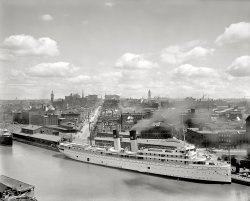
- Sault Ste. Marie: 1905
- Michigan circa 1905. "Sault Sainte Marie Canal celebration. Reviewing stand and Indian village." Dry plate glass ... her stern. Also, parts of the Wolverine have survived in Erie, PA, and the wreck of the Essex does exist in Duluth, MN. See the work of ... Posted by Dave - 10/27/2019 - 3:23pm -
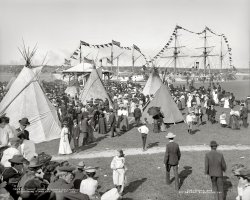
- Badger State: 1900
- ... "leg" was a huge structure on wheels -- on the City Ship Canal, next to the Marine Elevator. View full size.
Sis ahoy! I ... old Laker beside her are fascinating, however the little "Erie Canal barge" is amazing.
American Colossus This image appears in ... Posted by Dave - 08/14/2012 - 8:22pm -
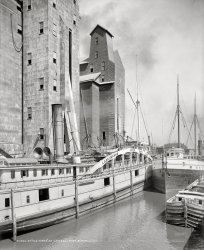
- Buffalo Dredging: 1905
- ... The right side of this picture includes the Black Rock Canal, while the left side is the Niagara River. As a child in the '60s (long ... I believe that the canal was an extension of the old Erie Canal that brought barges down from Lockport and North Tonawanda into the ... Posted by Dave - 03/10/2021 - 4:02pm -

- Harlem River: 1890
- ... removed when they widened the Harlem River and created The Erie Ship Canal. Today the arch piers that touch the river are now one large arch like ... Posted by Dave - 07/20/2012 - 1:33pm -
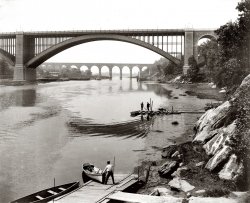
- Dog Cakes: 1910
- ... 70 Genesee Street in downtown Utica, within sight of the Erie Canal.
In 1937, the building was tripled in size to accommodate the needs ... Posted by Dave - 08/15/2012 - 3:06pm -
![Dog Cakes: 1910 Utica, New York, circa 1910. "United Commercial Travelers of America building." On a block offering a cornucopia of goods and services: Dog Cakes (not to be confused with Twentieth Century Lunch three doors down), dog collars, bananas, cigars, an amusement arcade (the Shooting Gallery), coal, shoes, trunks and, finally, crockery and glassware. 8x10 inch glass negative View full size.
Close to homeThis building is now an apartment complex, but most of the buildings to the right are gone, lost in a massive fire in 1948. Among them was my father-in-law's store, just out of the picture. If you could pan to the right, I'd appreciate it!
[Done. - Dave]
OK I'll BiteWhat's a dog cake?
What better to eat with Dog Cakes butDog Milk!
I took this photo of a can of Dog Milk that I saw in a Restaurant where I was dining in Japan a few years ago.
I asked the waitress how many dogs had to be milked to get a whole can of Dog Milk, but she didn't seem to understand.
70 Genesee StreetIn 1905, the company needed more office space and moved to this building, at 70 Genesee Street in downtown Utica, within sight of the Erie Canal.
In 1937, the building was tripled in size to accommodate the needs of more than 200,000 policyholders.
View Larger Map
The lunch is up to dateI'm reassured. If they advertised a 19th Century lunch, it would be ten years past its expiration date. Which is only four years past the Pure Food and Drug Act.
Kid-Free Eatery"20th Century Lunch -- For Ladies and Gentlemen"
Penny ArcadeThat's a great view of an old penny arcade, taken at a time when many of the attractions actually did cost only one cent. At the doorway is what appears to be a 44-note piano. These were usually set up to play a tune for a nickel, although the operator could have set it to play continuously as a means to entice passersby to enter. Along the right wall can be seen a row of Mutoscopes similar to the ones in the photo below. These played a moving picture supplied by individual frames printed on cards and formed into a reel. Each real contained one short movie, and since each Mutoscope held only one reel, the arcade would have many Mutoscopes in order to offer a variety of movies.
"Dog Cakes" - No dogs addedSpratts "Dog Cakes" was the first mass-produced dog food. James Spratt came up with "Patented Meat Fibrine Dog Cakes" after seeing dogs eating hardtack biscuits. The biscuits were initially marketed to country gentlemen in England for their hunting dogs.
Production was relatively limited until after James Spratt's death. However, in the 1880s, the company went public and became one of North America's marketed company in the 20th Century. They were eventually bought out by Purina.
Charles Crufts, who founded the Cruft's Dog Show began as a clerk for Spratt's.
Spratt was secretive about the actual meaty ingredient in his "cakes" and early ads in England intimated it was buffalo.
(The Gallery, Dogs, DPC, Stores & Markets, Utica)](https://www.shorpy.com/files/images/4a19575a.thumbnail.jpg)
- Power and Light: 1904
- ... me Reminds me of the powerhouse at Lock 7 on the Erie canal when I worked there. Originally the dynamo/generator was run by a water ... Posted by Dave - 09/15/2012 - 3:28pm -
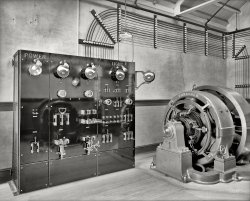
- S.S. Utica: 1910
- ... the Interstate Commerce Commission, citing the 1912 Panama Canal Act, ruled that American railroads could not also engage in marine transportation, and the NYC (as well as Erie, Pennsylvania, and Lehigh Valley) sold their steamship operations on the ... Posted by Dave - 08/14/2012 - 8:50pm -
![S.S. Utica: 1910 Circa 1910. "Freighter S.S. Utica, New York Central and Hudson River Railroad Line." 8x10 inch glass negative, Detroit Publishing Company. View full size.
1904-1949Constructed by the Detroit Ship Building Co., this 325-foot package freighter was launched April 28, 1904, at Wyandotte for the Western Transit Company, the marine operation of the New York Central on the Great Lakes.
In 1915 the Interstate Commerce Commission, citing the 1912 Panama Canal Act, ruled that American railroads could not also engage in marine transportation, and the NYC (as well as Erie, Pennsylvania, and Lehigh Valley) sold their steamship operations on the Great Lakes. Many of the vessels were consolidated under a new firm, Great Lakes Transit Corporation, for which the Utica ran from 1916 until 1945. That year, GLTC sold her to Chilean interests who renamed her Quintay. She was towed down the Chicago River, the Chicago Sanitary and Ship Canal, the Illinois River, and eventually the Mississippi to New Orleans.
The Quintay stranded and became a total loss on Penguin Island in the Messier Channel, Chile, on April 28, 1949, on a voyage from Callao to Punta Arenas while carrying general cargo and drums of oil.
Steamship Utica
Beeson's Marine Directory of the Northwestern Lakes, 1908
Steamship Utica, built in 1904 for the Western Transit Co. of Buffalo, N.Y. Gross tonnage: 3533, length: 325 ft., beam: 44 ft.
HmmmmI wonder what the three planks on the side of the hull are.
[Docking fenders. - Dave]
Rounding the Eastern Continent?I was not aware a vessel of this size could move South out of Lake Michigan and down thru to New Orleans in the canal/river system.
[As noted below, the Utica was a Great Lakes freighter. - Dave]
(The Gallery, Boats & Bridges, DPC)](https://www.shorpy.com/files/images/4a16007a.thumbnail.jpg)
- Meet the Loomises: 1939
- ... days to create farmland. However, once the Erie Canal, and later, the railroads, came in and opened up the fertile (and ... Posted by Dave - 06/12/2020 - 7:01pm -
![Meet the Loomises: 1939 Social Distancing 1.0 -- no matter how close you get, these folks are always at least six feet away.
October 1939. "Graveyard, Shaftsbury Center, Bennington County, Vermont." You can exhume the hi-res Loomises by clicking here. Acetate negative by John Vachon. View full size.
United AboveDivided Below. (Okay, I'll bite: What's that ball?)
Now, but before the trees in frontFoo. Having once again forgotten how to embed a Street View.
(Edit: Thanks. I've told others in the past how to embed Street View, but, as happens, this time didn't find the trick. A note in the FAQ/Instructions would be handy.
2008:
)
Anyway, trees and jet trails now, but the fence remains.
Vachon had such a good eye.
An acorn?If it is a giant acorn, it is a clumsy image, given its disproportion to the tree. But a tree by itself, or an acorn by itself, might not convey anything, and an acorn proportional to the tree would not be noticed. It brings to my mind the verse from the gospel of John, "Unless a grain of wheat falls into the earth and dies, it remains alone; but if it dies, it bears much fruit." It might be difficult to portray the fall of a grain of wheat in sculpture, but a tree and an acorn seem readily intelligible.
Not much has changedExcept for more trees. It's always interesting to see how many more trees exist today than in America of the early 20th century.
AcornThank you for that, Archivist. But what does the oak signify in this context? I must confess I’m a bit adrift here. I get that the chain is united above and divided below (whatever that really means), but does it also refer to the family – united in life, divided in death? I’m puzzled.
Forests in New England come full circleMuch of New England was clear cut of timber in the pre-Revolutionary days to create farmland. However, once the Erie Canal, and later, the railroads, came in and opened up the fertile (and flatter) lands of the Midwest to farming, most of the agricultural lands were abandoned, and the forests regrew. It took a couple of hundred-odd years, but now the forests are more verdant than before.
Never mind the acornThe more important part of the carving is the broken chain, symbolizing an ended life. This can also refer to the "divided below," meaning the family circle which is now broken, while "united above" refers to the deceased reunited with God in Heaven.
Clarrisa, ClarissaAnyone else notice that Clarissa's name is misspelled on her headstone?
[Or if her name is Clarrisa, the typo is on her son's headstone. - Dave]
Ah, the Loomis clan.Fairly prolific bunch of New England settler folk. Among their many descendants are such luminaries (Loomis-naries?) as Doodles Weaver and his niece Sigourney.
Got a Loomis in my own family tree, too—the same one on both sides, as a matter of fact. She's the reason my parents were seventh cousins, and the reason an ex and I (who met by chance a quarter of a world away, on another continent entirely) are eleventh cousins on both sides of our families.
New England genealogy, the source of endless amusement.
Interesting IconHere's my take. The tree is a symbol of Jesus and the cross in a lot of Christian communities worldwide. A fruit (or acorn) bearing tree would be a symbol of spiritual rebirth and to family. The chain and the caption of "United above, divided below" represents the passing away of a loved one who will be reunited with family again in heaven. Now tell me I'm wrong.
Illicit Loomis branchOne branch of New England Loomises drifted West to Madison County, New York, and for several generations were known as the “Loomis Gang,” operating out of the Nine-Mile Swamp, not far from Utica. They alternated horse theft with other larcenies, and were adept at escaping raids by the local sheriff. Witnesses to their offenses were often stricken with amnesia around the time the cases reached the court docket. Only the eventual deaths of the key figures brought an end to the Gang’s colorful adventures.
(The Gallery, John Vachon)](https://www.shorpy.com/files/images/SHORPY-8b22981a1.thumbnail.jpg)
- Beautiful Utica: 1905
- ... Elevated Streetcar? The streetcar is rolling over the Erie Canal, which was later filled in at that location, and named Oriskany Blvd. The ... Posted by Dave - 11/14/2013 - 2:32pm -
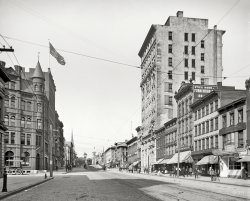
- A Foggy Day: 1941
- ...
Transportation Hub The first two versions of the Erie Canal, along with the West Shore railroad, passed directly through Fort Hunter ... Posted by Dave - 11/05/2013 - 11:06pm -
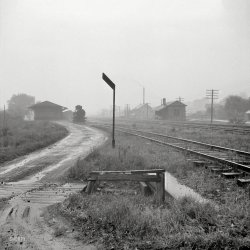
- Bedded Wheat: 1906
- ... to get to the Eastern Seaboard communities it had to go by Erie Canal barge. It made sense to mill it in Buffalo so it could be packed more ... Posted by Dave - 08/20/2012 - 11:06am -
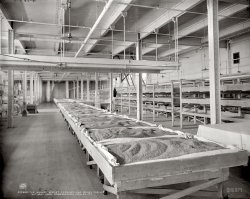
- Flour Power: 1911
- The Buffalo River, city ship canal and flour mill elevators circa 1911. "A busy section of the canal -- Buffalo, N.Y." 8x10 inch glass negative. View full size.
... launched 2 July 1892 also by Globe, ran for the Erie & Western Transportation Company, a subsidiary of the Pennsylvania ... Posted by Dave - 08/06/2014 - 10:50am -
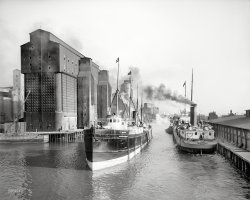
- River City: 1900
- ... is imported via the Peace Bridge between Buffalo and Fort Erie, Ontario, I believe. The import arm of the brewery is located in Buffalo. ... boards, and water bikes so one can paddle in the Erie Canal and Buffalo River to investigate the silos, and returning wildlife.
A ... Posted by Dave - 09/22/2017 - 8:39am -
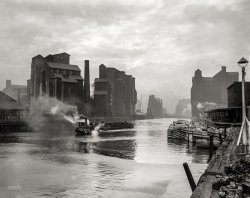
- City of Ottawa: 1907
- ... Rail Road. Sold in 1906 to the Montreal & Lake Erie Steamship Company, reflagged Canadian, repowered, and renamed the City of ... was brought down the Chicago River, Sanitary and Ship Canal, and the Illinois and Mississippi Rivers for a conversion that never ... Posted by Dave - 01/22/2018 - 11:21pm -
![City of Ottawa: 1907 Cleveland circa 1907. "Steamer City of Ottawa entering Cuyahoga Creek." 8x10 inch dry plate glass negative, Detroit Publishing Company. View full size.
What is supporting that bridge?Was this photo somehow manipulated or am I just not seeing the bridge/ferry landing properly? The shadows do not look correct, nor does the water beneath it. Is the dark pile which is barely visible made of steel, and all that is bearing the weight?
[It's a swing bridge in the open position. -tterrace]
Thanks Dave...makes perfect sense now! I hadn't considered that it was pointing 90 degrees from its normal orientation :-) (even though I have a defunct center pivot one close by)
The Name GameCity of Ottawa had a pretty long life on the lakes, a nearly went further. Christened the INDIA in 1871, she joined sister ships in service known as CHINA and the JAPAN. From the annals of the Toronto Maritime Society, these were no run of the mill steamers plying the Great Lakes.
"...The passenger cabin of each was a veritable palace compared to other ships then operating. The staterooms opened off a long open passageway in which the dining tables were set at mealtimes. At the forward end of the cabin was the men's smoking room, while at the after end of the passenger area the cabin opened out into a spacious and luxuriously appointed ladies' cabin, complete with grand piano. The woodwork up to the level of the clerestory was varnished, while the deckhead was painted white. Woodcarvings were in evidence everywhere. The entire cabin was fitted with carpeting and an elegant companionway led down to the main deck where the purser's office was located. As usual for the period, bathroom facilities were not provided in the staterooms but each room did boast "running water" in that reservoirs mounted over the sinks were filled daily by the stewardesses and after that gravity did the rest. The galley was located on the main deck and the food (of excellent repute) was brought to the cabin by means of a primitive lift."
Ironically, while she went by City of Ottawa renaming for most of her sailing days, the ship started as INDIA and ended that way as well, while being refitted for saltwater use during WWII. She was sent down the Mississippi River to New Orleans but deemed too old and unfit, was eventually laid up along Lake Ponchartrain, where it's believed she meet her end to scrappers in 1945.
Launched on June 20, 1871 at Buffalofor the Atlantic, Duluth & Pacific Company by Gibson & Craig and the King Iron Works, the India was the first of a trio of state-of-the-art iron passenger and freight vessels running between Buffalo and Duluth, the others the China and Japan. Beginning the next year and for the next decade it ran for the Lake Superior Transit Company, allied with a pool of railroad-related steamship companies and after that with the Anchor Line, part of the Pennsylvania Rail Road. Sold in 1906 to the Montreal & Lake Erie Steamship Company, reflagged Canadian, repowered, and renamed the City of Ottawa, the vessel operated as the firm's name implies. Its passenger accommodations were removed in 1913 when Canada Steamship Lines Ltd. acquired the vessel and placed it in the package freight trade between Hamilton and Montreal. Laid up in 1926, the City of Ottawa was sold back into American registry briefly in 1928 and renamed India, and the next year back into Canadian registry for the Algoma Central Railway Company and renamed Sault Ste. Marie, running between Fort William and Toronto. In 1930 it again entered American registry and reverted again to the name India, cut down to a coal barge. Requisitioned by the Maritime Commission for war service in 1942, the India was brought down the Chicago River, Sanitary and Ship Canal, and the Illinois and Mississippi Rivers for a conversion that never occurred. The India was dismantled on the shore of Lake Pontchartrain in 1945.
The William L. Scott was built at Buffalo in 1890 by the Union Dry Dock Company for that city's Hand & Johnson Tug Line. It was abandoned and dismantled in 1915, probably at Erie, Pennsylvania.
Swing bridge?Never was a real fan of bridges that move. Really like them sitting still and anchored.
Getting A LiftFor fans and non-fans of moving bridges, the current edition at or near that same spot is a rather impressive rail lift bridge, rather than swing version. Everything's up to date in Cleveland.
Tugging at your heartThe tug WILLIAM L. SCOTT, built in 1890, was steam powered and of wood construction, weighing 54 gross tons, with dimensions of 67.9 x 17.4 x 10 feet. It was dismantled in 1915 at Union Dry Dock, Buffalo Shipbuilding.
I suspect the boat may have been named for Pennsylvania congressman William Lawrence Scott (1828-1891).
(The Gallery, Boats & Bridges, DPC)](https://www.shorpy.com/files/images/SHORPY-4a25406a.thumbnail.jpg)
- High Bridge: 1905
- ... started out as an axeman(clearing trees and brush) on the Erie Canal, and advanced to one of the lead engineers. The water supply system of ... Posted by Dave - 06/05/2015 - 11:45am -
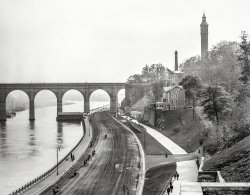
- Midland King: 1910
- ... that would bring the grain to Montreal for export, or to Erie Canal barges or eastern railroad connections. On its return trips it carried ... Posted by Dave - 10/14/2018 - 3:45pm -
